V&A Online Journal
Issue No. 4 Summer 2012
ISSN 2043-667X
Review of The Robert H. N. Ho Family Foundation Galleries of Buddhist Art at the V&A
Raymond Lam
School of Oriental and African Studies (London), Wang Fat Ching She (Hong Kong)Abstract
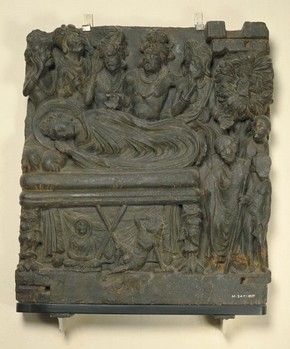
Figure 1 – Mahaparinirvana, sculpture, Pakistan, about 2nd century, carved schist, 53 cm x 48 cm. Museum no. Im.247-1927
Please note: This review was written in relation to the original Robert H.N.Ho Family Foundation Galleries of Buddhist Art which closed in November 2013.
This review surveys the spectrum of Buddhist sacred art in The Robert H. N. Ho Family Foundation Galleries of Buddhist Art. It provides an overview of the Gallery’s objectives and display of Buddhist sculpture, and examines each section of the Gallery with reference to pieces that distinguish it as a diverse and instructive repository of spiritual art.
The display under review is kept in The Robert H. N. Ho Family Foundation Galleries of Buddhist Art, which opened on 29 April 2009. The Gallery is named after the Foundation of Robert Ho Hung Ngai, son of Kuomintang general Ho Shai Lai and grandson of Sir Robert Hotung. It is also the first in the V&A solely devoted to the chronological and geographical development of Buddhist art, and occupies an accessible location next to the Museum’s John Madejski Garden. Mr.Ho’s philanthropic Foundation has been focused on helping people to gain a greater understanding of the Buddhist traditions and encouraging youth to take up the life-changing discipline of meditation. The Foundation also serves as a conduit for the promotion of Chinese arts and culture. (1)
The Gallery’s current display was formally called Buddhist Sculpture in Asia and presently houses a total of forty-five items. These forty-five objects are divided into four thematic halls in the Gallery. They are ordered as follows: ‘The Indian Subcontinent: the life and teachings of the Buddha’; ‘India, Sri Lanka and the Himalayas: Buddhism’s Decline in India and Expansion into the Himalayas’; ‘South-east Asia: Buddha, Monk and King’; and ‘East Asia: Creating Holy Images, Gathering Merit’. The doctrinal trajectory of these divisions is fairly straightforward. The first hall charts the early artistic developments of Indian Buddhism, from the schools of antiquity (Greco-Bactrian Gandhâra and native Indian Mathurâ) to the medieval Pala Empire (AD 750–1174), which set the classical standards for Indian Buddhist aesthetics. The second showcases Vajrayâna (Diamond Vehicle)art in the Himalayas, whilst the third highlights the dominance of Theravâda (Teaching of the Elders) culture in Southeast Asia. The fourth section on East Asia underlines the influence of the Mahâyâna (Great Vehicle) tradition’s teachings in China and Japan. The emphasis is mainly on the production of Buddhist art during the Chinese Imperial period, such as the Northern Qi and Yuan Dynasties.
Even a cursory, hurried glance over this quartet of themes should alert the visitor that this Gallery houses an impressive spectrum of sacred art. There are at least one or two pieces of sculpture from every geographic region that Buddhism has diffused into. While this is an important merit in its own right, one of the Gallery’s unspoken strengths is its robust emphasis on Indian Buddhist art, which while being familiar to the Buddhist practitioner, scholar or art aficionado, is something otherwise rarely seen in mainstream media. This oversight is of course regrettable, and the Gallery goes some way to correcting this by stressing Buddhism’s debt to its land of origin by dedicating an entire hall to it.
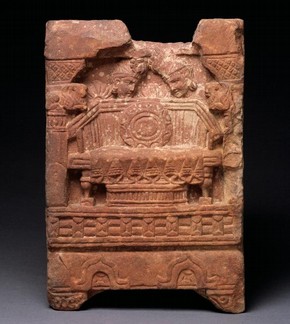
Figure 2. Throne of Buddha, sculpture, Mathura, India, about 2nd century, red carved sandstone, 33 x 22 x 9 cm. Museum no. Is. 1039-1883
The art of ancient Gandhâra (in which Buddhist art reaches its apex during the Kuṣâṇa era from BC 30–AD 375) blends Indian narratives of the Buddha’s life with Hellenistic techniques of naturalism and facial expression, and this is particularly discernible in the schist frieze of the death of the Buddha, which depicts a host of princes mourning over the Buddha who has passed into Parinirvâṇa (fig.1). (2) The lamenting figure below the Buddha and beside the meditating Subadha (the last disciple that the Blessed One ordained) is actually the guardian bodhisattva Vajrapâni, who was depicted as the Greek Heracles throughout Gandhâra and is instantly recognisable by the artistic combination of Heracles’ fine physique and his use of the Indian two-ended thunderbolt, the vajra. (3) The Gandhâran schist meditating Buddha and reliquary also combine Buddhism’s iconography and architecture (the reliquary would have been placed inside a commemorative structure unique to Buddhism called a stûpa) with the techniques of sculptors trained in Greco-Roman skills. (4)
A modest but important piece dating to the period of the Kuṣâṇa Empire is the Empty Throne image, from Mathurâin, modern Uttar Pradesh. (6) This item depicts an unoccupied throne, lovingly attended to by celestial attendants (fig.2).The empty throne may allude to either the Great Renunciation, the night on which prince Siddhartha fled his palace to eventually become Úâkyamuni Buddha, or might be celebrating the ineffable presence of the Buddha, which is beyond both existence and non-existence. Resting on the throne is a sun, a solar representation of the light of the Buddha’s illuminating teachings. The imagery hearkens back to an age when the Buddha was not yet depicted in human form and Buddhist art betrayed apparently ‘aniconic’ tendencies. (7) This still mysterious epoch spans from the early beginnings of Úâkyamuni’s dispensation and ministry to the turn of the Common Era; about four to five centuries. (8)
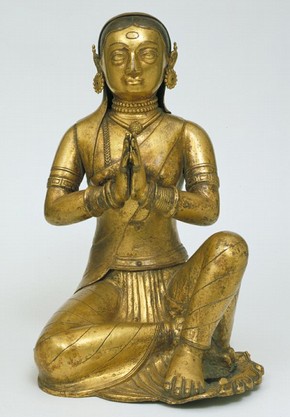
Figure 3 - Female donor figure, Negap, 1790-1810, gilt copper, 33 x 25 x 24 cm. Museum no. Im. 371-1914
Broadly speaking, the Himalayan hall features tantricart from India and the Himalayan region. It mainly covers depictions of Úâkyamuni and the female Buddha Târâ, although other personalities appear, such as a gilded copper with turquoise, coral and lapis lazuli piece of the Buddha Vajradhara; a cast gilded copper with red lacquer image of Amitâyus from China; and a basalt statue of Mahâkâla from Orissa, the fabled Indian tantric heartland. (9) One of the most striking figures here is the sculpture of a nameless female donor, which was produced around AD 1710–1810 during the Shah dynasty (circa AD 1500–2008) in Nepal. (12) Made of gilded copper, the anonymity of the kneeling woman contrasts with her resplendent figure, decked with the robes and jewels of wealth and nobility, possibly even royalty (fig.3). Overall, the diversity of the Vajrayâna sculptures in this section is impressive and offers an illuminating window into the tantric tradition’s Indic funnel through which it diffused into the Himalayan regions, particularly Tibet and Nepal.
Royalty and its relationship to Buddhism form the subject matter of ‘South-east Asia: Buddha, Monk and King’. Its centrepiece is a complete Burmese royal shrine from Mandalay, dated to 1800–1900. (13) Yet I find two of the section’s most religiously impressive pieces to be the plaster replicas of sculpted murals from Borobudur, Indonesia.These replicas have been titled, The Buddha Competes in an archery contest and Scene from Gandavyuhasûtra. (14) The former label is actually slightly misleading, as while Mahâyân atheology does envisage the Buddha’s pre-enlightened life as destined for Nirvâṇa, it is only after he is enlightened that he can truly be called a Buddha. (16) More accurately, the fresco depicts the prince Siddhartha Gautama competing for and winning the hand of his wife, Princess Yasodharâ, through a shooting contest. Scene from Gandavyuhasûtra depicts the pilgrim Sudhana receiving teachings and blessings from the bodhisattva Samantabhadra. (17) The Gandavyuha sutra was incorporated into the vast Avataṃsaka canon and is famous for its breathtaking, inspired imagery of cosmic interconnectedness. (18) In its narrative, Sudhana goes on a journey to visit a succession of enlightened teachers, from kings and priests to goddesses and people of common professions (fig.4). The meeting with Samantabhadra represents the climax of the story, and is appropriately depicted in the mural as a joyous, sacred occasion.
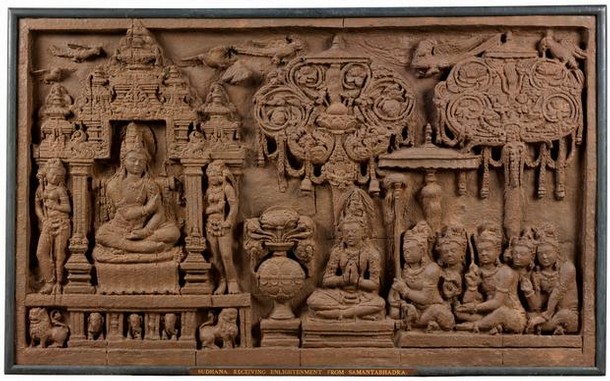
Figure 4 - Panel, Java, Indonesia, 8th century, plaster cast, 121.9 x 201.9 cm. Museum no. Im.170-1926
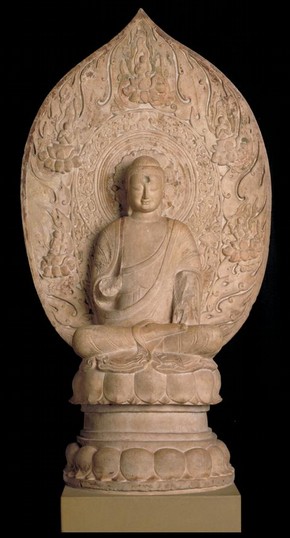
Figure 5 - Seated Buddha, Figure of Buddha, Hebei, China, 550 – 577, marble sculpted, 166.7 x 92 x 40 cm. Museum no. A.36-1950
The East Asian hall comprises slightly fewer items compared to the other sections, although these sculptures compensate with their size. One of the themes they showcase is the aesthetic of Chinese religious art. Of strikingly austere spiritual beauty is the Yuan dynasty-era (AD 1271–1368) arhat figure. (19) Crafted out of wood with traces of paint, the figure’s sitting pose exudes a calm otherworldliness that is qualified by an almost down-to-earth, gruff expression directed to his left. The marble Seated Buddha is an exemplary instance of Chinese Buddhist art during the Northern Qi dynasty (fig.5), contrasting the Buddha’s serene, reassuring expression with his complex aura and halo of divine flames and emanating enlightened beings. (20) Each sculpture displayed in the Gallery is supplemented by informative text, and the introductions to each hall provide clarification regarding the doctrinal context and social setting of the sculptures. This is of course necessary for visitors who are unfamiliar with Buddhist thought or Buddhist art. The introductions help to ease the Gallery’s guest into the doctrinal, historical and cultural rationale behind signature features of the art, from the sometimes disconcerting range of hand positions (mûdra) to the symbolism of the ornamentation (such as lotuses and swords) on the sculptures. This is a noteworthy accomplishment, given the difficulty associated with writing introductions to world religions and spiritual movements.
The Gallery attempts to host not merely beautiful objects, but the vision behind them. The Buddha’s own vision, when he founded his movement, was a lofty one of liberating all beings from the cycle of suffering known as saṃsâra. (21) This ideal lies behind each of the displayed objects by virtue of their religious heritage. Time and again the Gallery, through its procurement and selection of the present display and informative commentary, amply makes clear the Buddhist relationship between moral purification, ethical discipline and artistic appreciation. As noted in the clerical and monastic regulations preserved in the Mûlasarvâstivâda-Vinaya, the craft and enjoyment of attractive religious art can be a springboard into the patronage of religion. (22) In the context of Buddhist sculpture, the Gallery has brought together a transnational aesthetic that is crisp and compact, yet broad enough to give an idea of Buddhist art’s diversity. It offers an exhibit that will retain a lasting value to discerning visitors and Buddhists for many years to come.
Endnotes
(1) The Robert H. N. Ho Family Foundation. ‘What We Do’. Accessed January 2, 2012. http://www.rhfamilyfoundation.org/what-we-do
(2) The Death of the Buddha, sculpture, Gandhâra, AD 100–300. Museum no. Im.247-1927.
(3) Foltz, Richard. Religions of the Silk Road: Premodern Patterns of Globalization. 2nd edition. New York: Palgrave Macmillan, 2010: 44. As his name suggests, Vajrapâni is the one with the ‘vajra-in-hand’. Despite being a religion that grew from the œramaṇa intellectual soil, ancient Buddhism owes a significant part of its mythology to even older Vedic theologies of godhood and divinity. We can trace Vajrapâni’s iconography back to the storm god Indra, whose worship as the king of the Vedic gods dates back to at least the first half of the second millennium AD. For a fuller analysis of the word ‘vajra’, which was originally Indra’s weapon and appropriated by Vajrapâni, see: West, Martin Litchfield. Indo-European Poetry and Myth. Oxford: Oxford University Press, 2007: 251–2.
(4) Buddha seated in meditation, sculpture, Gandhâra, AD 200–400, Museum no. Is.108-2001. Reliquary in the form of astûpa, sculpture, Gandhâra, AD 200–500. Museum no.Is.299-1951.
(6) The Adoration of the Empty Throne, sculpture, Mathurâ, AD 100–300. Museum no. Is.1039-1883.
(7) For a comprehensive if slightly outdated analysis of aniconic Buddhist art, see: Huntington, Susan L. ‘Early Buddhist Art and the Theory of Aniconism’. Art Journal 49, 4 (1990): 401–8.
(8) Heller, Amy. Early Himalayan Art. Oxford: The Ashmolean, 2007: 13: ‘The earliest extant Indian Buddhist art dates from the first centuries AD, with the development of the earliest figural representations in stone of the historic Buddha Śākyamuni (c.563–483 BC).’ Subsequent formulations in Buddhist doctrines led to the making and use of images via symbolic representations such as the footprint, tree, or empty throne.
(9) Vajradhara, sculpture, Nepal, 1500–1600. Museum no. Im.41-1910. Amitâyus, sculpture, China, 1650–1700. Museum no. M.436-1936. Mahâkâla, sculpture, Orissa, 1100–1200. Museum no. Im.10-1930.
(12) Female donor figure, sculpture, Shah dynasty, Nepal, 1100–1200. Museum no. Im.371-1914.
(13) Buddhist Shrine and associated objects, shrine, Mandalay, Burma, 1800–1900. Museum no. Is.11:1 to 24, 28 to 31-1969.
(14) The Buddha Competes in an archery contest, plaster cast of original relief, Borobudur, 700–800. Museum no. Im.172-1926.Scene from Gandavyuhasûtra, plaster cast of original relief, Borobudur, 700–800. Museum no.Im.170-1926.
(16) For a comprehensive study of the concepts, issues, debates and problems in Buddhology, see: Guang Xing. The Concept of the Buddha: Its evolution from early Buddhism to the trikâya theory. London and New York: Routledge Curzon, 2005.
(17) Samantabhadra is one of the central bodhisattvas in Mahâyâna Buddhism. He symbolizes the practices of the bodhisattva, the crucial figure and ideal in the Great Vehicle, and his ten vows are detailed in the Gandavyuhasûtra and taken up by Sudhana. See: Cook, Francis. Hua-yen Buddhism: The Jewel Net of Indra. University Park; London: The Pennsylvania State University Press, 1977: 78. Composed most likely in Central Asia, perhaps compiled in the oasis kingdom of Khotan, the Avataṃsakasûtra is no longer extant in its original language (most likely Sanskrit), although it has been preserved in the Chinese canon. The only complete English translation is in Cleary, Thomas. The Flower Ornament Scripture: A Translation of the AvataṃsakaSûtra. Boston and London: Shambhala, 1984–1993.
(18) Gyatso, Tenzin (HH The Fourteenth Dalai Lama). The Universe in a Single Atom: The Convergence of Science and Spirituality. New York: Morgan Road Books, 2005: 88 – 9.
(19) Figure of an arhat, sculpture, Yuan dynasty, 1271–1368. Museum no. A.63-1937.
(20) Seated Buddha, sculpture, Northern Qi dynasty, AD 550–77. Museum no. A.36-1950.
(21) This central ideal of universal liberation is eloquently narrated in: Gethin, Rupert. The Foundations of Buddhism. Oxford; New York: Oxford University Press, 1998: 8: ‘So who, and indeed what, was the Lord Buddha? …in brief, the word buddha is not a name but a title; its meaning is ‘one who has woken up’. This title is generally applied by the Buddhist tradition to a class of beings who are, from the perspective of ordinary humanity, extremely rare and quite extraordinary… A buddha… awakens to the knowledge of the world as it truly is and in doing so finds release from suffering. Moreover–and this is perhaps the greatest significance of a buddha for the rest of humanity, and indeed for allthe beings who make up the universe–a buddha teaches. He teaches out of sympathy and compassion for the suffering of beings, for the benefit and welfare of all beings; he teaches in order to lead others to awaken to the understanding that brings final relief from suffering.’
(22) Schopen, Gregory. ‘Art, Beauty, and the Business of Running a Buddhist Monastery in Early Northwest India’. In Buddhist Monk and Business Matters: Still More Papers of Monastic Buddhism in India, edited by Gregory Schopen, 20–1. Honolulu: University of Hawai‘i Press, 2004.
Issue No. 4 Summer 2012
- Editorial
- A portrait of the 'Raphael of silk design'
- Encounters in the Archive: Reflections on costume
- A study of a Ming dynasty ceramic pillow
- Another dimension: integrating music with the Medieval & Renaissance Galleries
- William Bower Dalton: Potter and teacher
- The silent traveller: Chiang Yee in Britain 1933-55
- Room 38A and beyond: post-war British design and the Circulation Department
- The Silvern Series: Photographs from the collections of the South Kensington Museum
- Review of The Robert H. N. Ho Family Foundation Galleries of Buddhist Art at the V&A
- How to submit a proposal to the V&A Online Journal